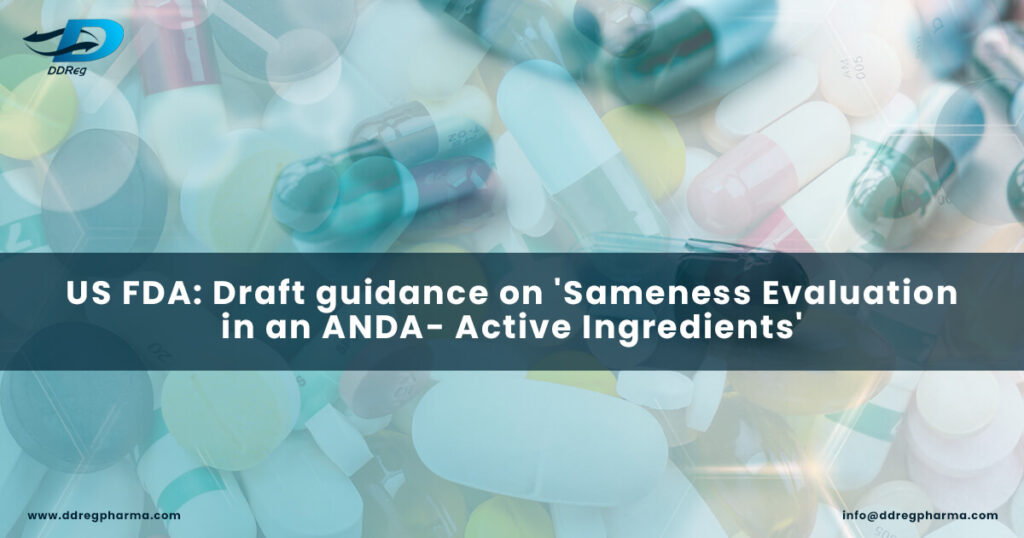As per US FDA pre-requisites for Abbreviated New Drug Application (ANDA) filings, applicants should be able to demonstrate their product’s sameness or similarity to its innovator product or Reference Product (RP). All the data generated by applicants on generic versions should be equivalent or the same as that for reference-listed drugs (RLD). The CDER recently issued a new US FDA draft guidance for the industry that provides recommendations for ANDA applicants to demonstrate this ‘sameness’.
As per the recommendation by the US FDA, under the draft guidance, applicants should comprehensively evaluate and assess any potential for changes regarding the active ingredient while it is under the manufacturing stage. Lack of data to support the similarity between the generic product and RLD is a key Right to Reject (RTR) point. Though the information criteria is at the FDA’s discretion, the intent in drafting the guidance document was to provide considerations that ANDA applicants must take when determining what an active ingredient is according to the FDA, considerations for similarity/sameness for synthetic peptides & more complex drugs, and how active ingredients should be characterized. According to the FDA, the chemical form of an active ingredient also includes the entities that make the drug an ester or salt. ANDA applicants should also consider any non-covalent entities i.e., chelate, clathrate, complex, when assessing sameness, and just because a drug product and RLD are different in their physical forms does not mean that the their active ingredient sameness cant be demonstrated by ANDA applicants [1].
Considerations for active ingredient sameness in synthetic peptides & complex mixtures
- Primary sequence & physicochemical properties
- Secondary structure
- Oligomer/aggregation states
- Biological activities (by in-vitro or animal studies)
Complex mixtures: all relevant data and other relevant scientific evidence should be evaluated by the FDA to see if a complex mixture’s active ingredient has been characterized adequality to facilitate assessment of the active ingredient sameness. As per the US FDA draft guidance document, examples of complex mixtures can include:
- naturally-derived entities that constitute several components
- synthetic polymers
- semi-synthetic or synthetic mixtures
Characterizing active ingredients in the drug product
- any entities of a molecule that make the drug a salt or ester is part of the active ingredient. Hence the salt or ester form of the active ingredient should be the same in the proposed product and RLD.
- A complex, chelate, or clathrate is part of the active ingredients provided that it instigates the desired pharmacological activity
- For solid oral dosage forms, the active ingredient will not include complex-forming excipients unless that excipient is not intended to instigate the desired pharmacological activity. For example, some complex excipients such as polymers are used to mask unpleasant taste. This is not part of the active ingredient or form a new active ingredient if they form bonds with an active ingredient.
- Carbohydrates that form complexes with active ingredients for the purpose of stability are also not part of the active ingredient. However, in some situations, certain carbohydrate complexes are needed to ensure the intended therapeutic action of the drug. In this case, the carbohydrate is considered part of the active ingredient.
- Intact gadolinium complexes in gadolinium products that are used for medical images should not dissociate and produce free gadolinium ions as they are toxic.
By issuing the US FDA draft guidance on the sameness evaluations for active ingredients in an ANDA, the FDA provides support to ANDA applicants in determining the similarity, or sameness, of the active ingredients for a generic product and its RLD [2].
As part of our pharma regulatory consulting portfolio, our team at DDReg provides end-to-end regulatory services for ANDA submissions to the US FDA. Additionally, using our deep regulatory subject-matter expertise and regulatory intelligence we have also tackled various challenges related to ANDA filings including legibility checks to avoid RTRs for our customer organizations.
[1] US FDA. Sameness Evaluations in an ANDA- Active Ingredients: Guidance for Industry. 2022
[2] US FDA. Abbreviated New Drug Application (ANDA). 2022

